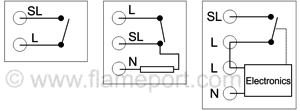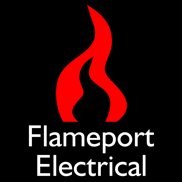Room thermostats
These are wall mounted, and are used to control the air temperature. Internally, most room thermostats are simply a switch which is ON when heat is required and OFF when the room is warm enough.
Wired thermostats
These are connected with fixed wiring, and typically 3 core and earth cable is used. This provides a live and neutral as a power supply, and a switched live output.
Some thermostats do not require power, and so only the live and switched live are used. This also applies to battery operated types, where batteries power the electronics in the thermostat despite a mains supply being available via the wiring.
Some digital thermostats use the mains as the power supply, and so will have a neutral terminal. Many mechanical thermostats also require a neutral for a small heater inside the thermostat which is activated when the thermostat is on (requesting heat). This provides better control of the room temperature.
Wireless thermostats
Provided as two components. The actual thermostat is a battery powered item which sends a signal by radio to the receiver unit.
The receiver is wired to the supply in the same way as a normal thermostat - live and neutral provide a power supply, and there is a switched output. The output can either be a single terminal which is live when heat is required, or 'volt free' terminals in which case there are two terminals for the output.
The receiver is normally located close to the boiler or wiring centre.
The only additional setup required is to match the thermostat and receiver modules - some are supplied matched, on others a certain combination of buttons must be pressed to ensure the signal from the thermostat is received correctly.
The only advantage of a wireless thermostat is when installing one on a system which for some reason has no thermostat at all. This avoids damage to decoration which would occur when installing cables.
Wireless thermostats are NOT intended to be moved around the building, and they cost significantly more than wired types. There is also the added inconvenience of having to repalce the batteries - when the batteries fail, the heating will not work. Just what is needed on Christmas Day when the shops are closed.
Typical thermostat connections
 In all cases, the thermostats is a simple switch, connecting a switched output to live when heat is required.
In all cases, the thermostats is a simple switch, connecting a switched output to live when heat is required.
Where the thermostat contains an accelerator heater or electronics, a neutral connection is also required.
Three types are shown here. The first is a simple 2 wire thermostat. When heat is required, the two terminals are connected together. This could either be a mechanical device, or a battery powered electronic one.
The second is a mains powered mechanical thermostat with accelerator heater. The heater is switched with the thermostat and improves the thermostat response time. It is important to ensure the L and SL terminals are connected correctly - if reversed, the heater will be powered continuously.
The third is an electronic mains powered thermostat. The electronics require continuous power, and connect the L and SL terminals together when heat is required. On some types it is necessary to install a link between the two L terminals.


